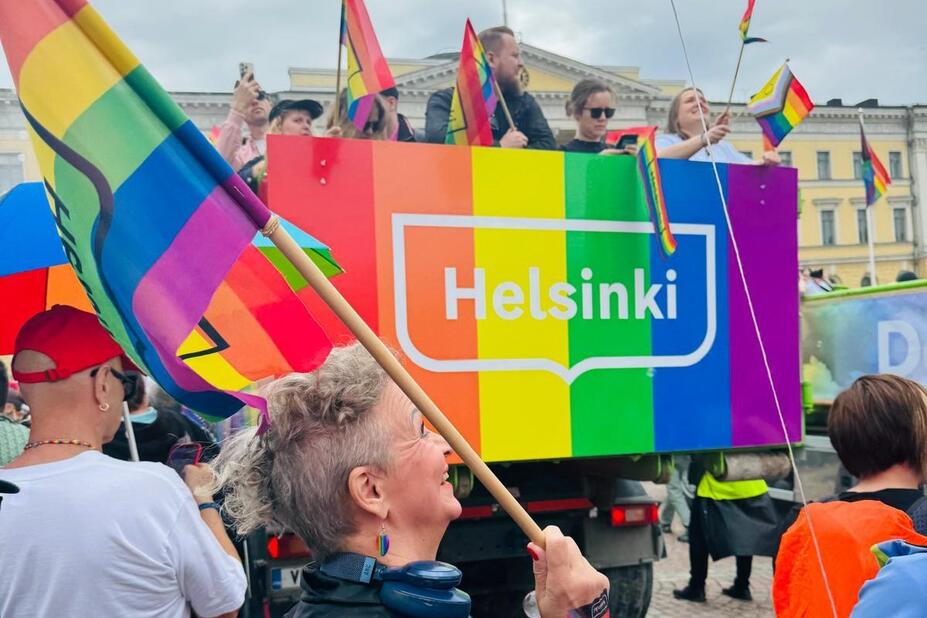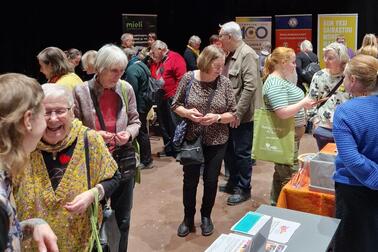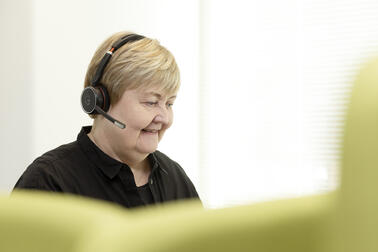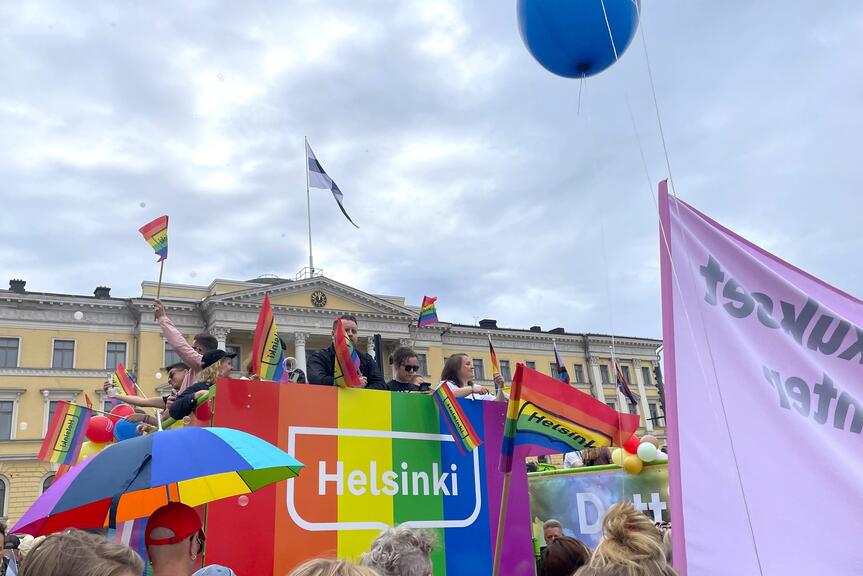
The City of Helsinki’s senior centres organise LGBTQIA+ activities for senior residents of Helsinki throughout the year. It is important to give visibility to the LGBTQIA+ work carried out for the rights of sexual and gender minorities. The senior centres marched together for the first time in the recent Pride Parade. The steps taken in the procession symbolise a larger change in the daily life of senior centres.
Kinapori Senior Centre sets an example for others
Kinapori Senior Centre is an expert in LGBTQIA+ work with seniors. The senior centre took part in the Pride Parade for the first time in 2017. Social instructor Saara Kallo has been working at the senior centre since 2017. She believes that senior centres also need to have a safe atmosphere for discussion for those who question and wonder. Challenging opinions are addressed, and efforts are made to increase understanding. As LGBTQIA+ activities and events are voluntary for clients, they participate in these activities according to their own interest.
“Many people wish to come and talk when LGBTQIA+ rights become a part of their lives because of a grandchild’s sexual orientation, for instance,” Kallo says.
Various discussions often take place in connection with Kinapori’s LGBTQIA+ events. In everyday life, these matters require knowledge and an understanding of diversity. Employees wish for training that would teach them not only the terminology but also how to interact with people.
“LGBTQIA+ work is not just about terminology: it involves being considerate of others through gestures and words in everyday life. Leaving your own preconceptions behind requires you to engage in continuous dialogue with yourself,” Kallio muses.
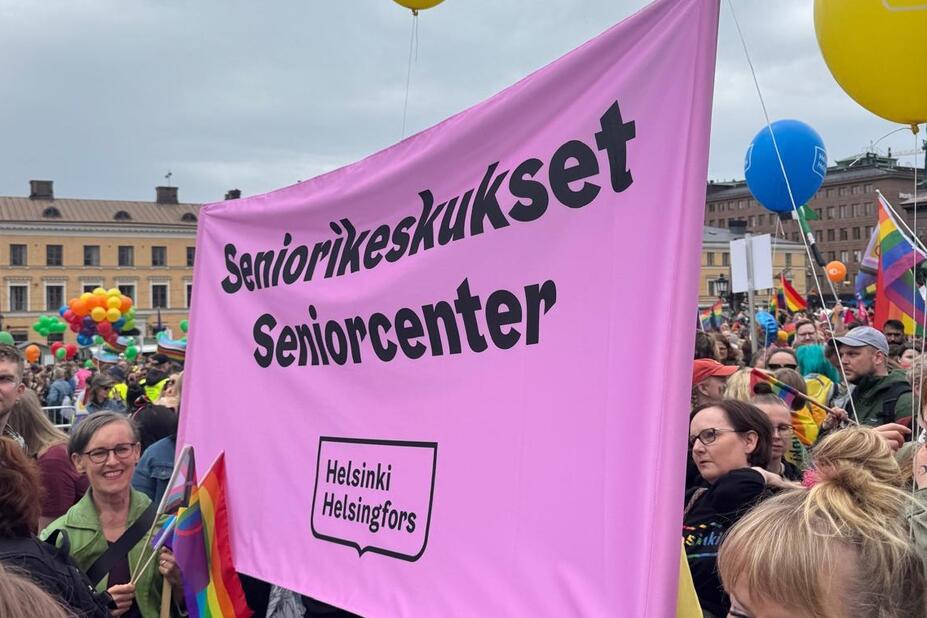
Acceptance is needed, even after decades
During the Pride Month, the senior centres’ calendars featured exercise sessions, dance sessions, sing-alongs and plenty of opportunities to learn something new. Craft workshops and exhibitions focusing on LGBTQIA+ minorities added colour to the senior centres’ walls.
On Tuesday during Pride Week, the day started with a reminiscence café at Kinapori, led by drag artist Jari Vihinen. The coffee and baked goods went like hot cakes and the seats filled up as Vihinen talked about his career over the decades. The previous day’s nail workshop must have also been a success, considering that many members of the audience had their nails painted in the colours of the rainbow.
The stories told by Vihinen, who continues to perform under the alias Madame IsaDora, highlighted the prejudices faced by LGBTQIA+ artists. The early years of his career included colourful twists and turns, but Vihinen has continued to move forward with courage.
“Tolerance, love and forgiveness. We are moving forwards, hopefully with light steps,” Vihinen sums up.
The audience took part in the reminiscing by sharing their own experiences. Opportunities for peer support and sharing are important, even if they take place decades later.
The next performer of the morning at Kinapori, namely Timo Tähkänen alias Maimu Brushwood née Huolirinta, has also been creating queer art for almost a decade. Tähkänen, who is a multidisciplinary artist, was able to put the change in attitudes into words, as he has previously worked at a senior centre. The story told on Tuesday was a playful reflection of the story of the venue’s growth with regard to LGBTQIA+ themes.
After the story time, the audience rushed towards Kinapori Senior Centre’s assembly hall. The rainbow disco had already started! Despite the rainy weather, the atmosphere remained warm for the entire day. The events were open to all clients of the senior centre, and no one was asked why they were participating. At the end of the day, it was easier than ever to see the significance of diversity as an enriching factor in the everyday life of senior centres.

Progress through cooperation
LGBTQIA+ work at senior centres is not the responsibility of just one person or unit. The activities are also promoted outside of events, with the support of various organisations and projects. Hanne Vartiainen, a project worker at the City of Helsinki’s senior centres, stresses that contact with organisations is helpful in reaching and consulting target groups. This dialogue makes it possible to support the ability of clients representing sexual and gender minorities to contribute to the realisation of equality in senior services. Experts by experience have been consulted for a guide on sensitive interaction with LGBTQIA+ seniors, for instance. Vartiainen herself has also noticed a willingness on the part of senior centre staff to participate in LGBTQIA+ activities and training.
“Our employees have become more broadly committed to diversity. Senior centres have come ‘out of the closet’, so to speak, and made their work visible.”
Knowledge and tools have made the activities bolder. This change impacts everyday life at a practical level, and LGBTQIA+ work with seniors does not rest solely on the shoulders of individuals. As an example, Vartiainen mentions discussion forums made up of clients and employees. She also says that targeted peer support groups have been set up at different senior centres in Helsinki, according to need and demand.
Senior centres expressed their support with open minds and joy
Senior centre employees were nervous about taking part in the Pride Parade, even though LGBTQIA+ themes have been part of everyday life at senior centres. Vartiainen, who acted as the contact person, mentions that the aim was to make participation in Helsinki Pride as easy as possible for first-time participants as well. For this purpose, an information session was held before the day of the parade, and employees had the opportunity to ask questions during the session. Kuisma Savisalo conveyed a message of encouragement from LGBTQIA+ seniors to those from the senior centres who intended to participate in Pride. Savisalo chairs Sateenkaariseniorit ry (Rainbow Seniors association), which is one of the key partners in coming up with and organising services for clients. Savisalo mentioned that senior centres have been a base for the activities of LGBTQIA+ seniors for years. That is why the joint participation of the senior centres in the procession was also welcome news for Savisalo.
“I hope that everyone will participate with an open mind and a happy heart and express their support for LGBTQIA+ people – both seniors and younger people,” Savisalo encouraged.
In the end, about twenty happy participants from the senior centres turned up to take part in the Pride Parade. Some wore colourful woollen socks, and there were a few umbrellas. Some said that they had taken part in the procession before, while for others this was the first time. The cheerful group set off from Senate Square, following a truck of the City of Helsinki, and there was no more nervousness in the air. The banner of the senior centres was raised high in the air, and it attracted friendly looks from the supporters gathered along the road.
In Kaivopuisto, the senior centre group was joined by a man who had travelled the Pride Parade route by tram. He said that he had taken part in Finland’s first Pride Parade in 1981, when about 20 people had taken part in the demonstration. This year, it is estimated that about 100,000 people turned up. The senior centres in Helsinki work throughout the year to ensure that everyone can age in an equal environment – both now and in the future.
Text: Marilla Timonen
